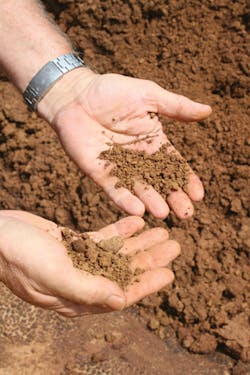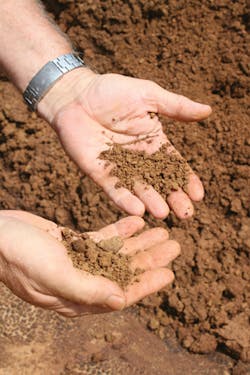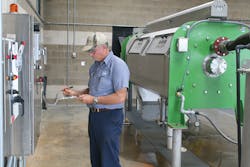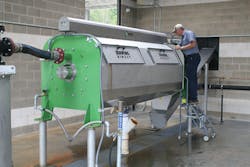Pressing Issues
By Larry Trojak
A surprise can be a wonderful thing - great for a birthday party, terrific in a horror film and generally welcomed by all. Businesses, on the other hand, tend to prefer things to remain constant, measurable and predictable. That same tenet holds true for water treatment plants, which, while used to dealing with daily fluctuations, thrive on sameness and repeatability. So when a new plant that Davidson Water Inc. (Lexington, N.C.) had recently inaugurated started producing levels of solids almost double what it had anticipated, the company worried that all its advance planning was for naught and the dewatering facet of the process was doomed. However, one of the key components in that effort, a new screw press, met the challenge, giving plant operators the results - and the peace of mind - they needed.
Growing Pains
Named after the county it serves, Davidson Water started modestly but today boasts more than 59,000 connections and a potential 35 million gallons per day (mgd) capacity. According to Tom Johnson, water plant superintendent, getting to that point has involved a series of upgrades.
“The original water treatment facility was built in 1961 and underwent several expansions over the years,” he said. “During that time, as growth around the county increased, a study was conducted and it was determined that capacities would need to be increased by 2015 to meet the expected demand. Two options - upgrading the existing plant and building a new one - were examined and the choice was made to go with a new plant. Construction was started five years ago, in 2010, and we officially opened this new facility two years ago.”
It should be noted that, while the former plant was rated for 20 mgd, the new one was designed with a capacity of 15 mgd. While that might look like a step backward, Johnson was quick to point out that was definitely not the case.
“The overall plan was not to retire the old plant but, rather, to make some modifications and upgrades and keep it alive,” he said. “Now, should demand start approaching the 15 mgd threshold of the new facility, we can bring the old plant online and easily have the added capacity we need.”
Addressing Solids
At Davidson Water, the ever-present challenge of what to do with solids removed from pre-treated water was, for years, dealt with in the most basic manner. Liquid sludge, the byproduct of natural solids and the ferric sulfate added as a coagulant, was discharged to an adjacent lagoon where it was dredged by a local firm and hauled off to be land-applied. While effective, the practice was not without some serious shortcomings, said Johnson.
“First of all, there are the costs associated with removal, hauling and application,” he said. But there were more than just financial concerns. “The capacity of the lagoons is, after all, limited, and if something came up that prevented the contractor from land applying - wet weather, oversaturated ground, etc. - we would find ourselves in a bind as the lagoons filled. Within a month or two, we would be near capacity - with the solids still being generated. It was obvious we needed to do some sort of solids treatment.”
Additionally they knew that when the new plant was brought online, they would be generating even more solids. So, plant staff began formulating plans for a better process to handle sludge.
Decisions, Decisions
Once it was determined that construction of a solids handling facility was in order, Johnson and his team started looking at the various approaches available for dewatering, the key component of any solids program.
“We considered several different technologies, but narrowed it down to a belt press and a screw press,” he said. “To choose between the two, we did a cost analysis which looked at water use, power use, man hours required for operation, and so on. The data from that study pushed us toward the screw press and the two major manufacturers in that area.”
To help make their final decision, Johnson said they then invited each manufacturer to come out to their Welcome, N.C., location with a mobile unit and conduct a pilot test, which they did on separate occasions. Based on those tests, he said, Schwing Bioset won out.
“The Schwing Bioset Screw Press used less water, less chemicals, less energy, and produced a better end product,” he said. “We knew we’d found our solution.”
Pulling It Together
The Davidson plant differs from others in the region in that it employs ferric sulfate as a coagulant. As a result, the characteristics of the sludge it produced were also different - Johnson described it as “less biological, more chemical.” This had to be dealt with when specifying for the dewatering effort.
“It was another hurdle for us,” said Johnson. “Years ago we switched this plant to that coagulant because we found that it had better qualities for trapping the fine solids and concentrating them into a sludge. At the time, no one had in mind what effect it could have on sludge processing; that was a whole new, unplanned set of challenges.”
At Davidson, sludge is sent to a clarifier tank where it settles and the clear water that separates is decanted off. With the sludge now concentrated in a blanket at the bottom of the clarifier, a variable speed pump is used to route it up to the solids building. There, a meter, controlled by the screw press, measures and directs the flow as the material is pumped through the reaction tank for polymer injection. The combined mixture of polymer and sludge is then pumped into the press for dewatering.
View of the Screw
The screw press installed at Davidson Water has been designed for durability, reliability, ease of operation and low power consumption - all prerequisites expressed by the utility prior to making its commitment. Because the unit operates at low speeds, wear is minimized, ensuring long component life. That low speed, however, does not impact product results. In fact, the Bioset Screw Press achieves dewatering results similar to those of a high-speed centrifuge - with a fraction of the energy consumption. In retrospect, said Johnson, their target dry solids content for the final product from the unit seemed overly conservative, but those targets were developed before committing to Schwing Bioset’s high-performance screw press.
“When we went into this, we wanted to be able to make 25 percent dry cake - that was our intended goal,” he said. “Suffice it to say we are doing that, and then some. It is not uncommon for us to generate product with a solids percentage in the mid-30s and several times we’ve topped 40 percent. That’s better than we ever could have imagined.”
Ease-of-operation, cited as one of Davidson Water’s concerns, is addressed in a number of ways, most directly through the screw press design, which allows for unattended operation - no additional personnel or specialized training are needed. In addition, periodic cleaning is fast and easy, according to Charlie Minter, Davidson’s lab technician and operator.
“The press features a clean cycle, which allows the unit to self-clean while it is operational,” said Minter. “To do that, a bar runs the length of the unit spraying down the screen and other key components; it’s almost like a car wash. That cleaning cycle is typically done once per day for three to five minutes and because we can remain running while doing so, production rates are not affected.”
By way of comparison, the unit that Davidson passed on runs three wash cycles each hour, resulting in significantly more water usage and, because the unit must be idled to do so, as much as a 10 percent lower rate of production.
Solid Performance
The initial pilot test of the screw press determined the percentage of solids going into the unit was in the 2 to 3 percent range and those percentages drove the design of the press Bioset delivered to Davidson. According to Johnson, however, that 3 percent value proved seriously conservative.
“Shortly after going online with the new press, we found the solids content of the sludge to be a steady 6 to 7 percent - almost double what we had anticipated. We were genuinely concerned that we’d missed the mark and the press - as designed for us - would not give us the throughput and efficiencies we’d hoped for. Turns out, our concerns were unnecessary; the press handled the heavier sludge well and has been doing so ever since.”
The numbers bear out Johnson’s enthusiasm for the unit’s performance. During a three-month monitoring period, operational costs associated with the screw press - specifically power and chemical costs - have been steadily decreasing while performance stats have been heading upward.
“We have been able to achieve a steady and consistent solids capture rate of 97.5 percent over that three-month time frame,” he said. “More importantly, however, solids content has gone from an average of 23.6 percent - itself, a decent number - to an amazing 38.4 percent. At one point we topped out at 42 percent, which seemed implausible when we started this project.”
Great Backup Plan
Equally positive is the new manner in which dewatered solids are dealt with at Davidson. Lagoon disposal has been scrapped, replaced instead by direct load out to a truck that hauls the cake off for dry land application. A new addition to the process, however, includes a 90’ x 120’ covered storage area located adjacent to the dewatering plant onto which the dewatered cake can be loaded and stored. Johnson said this new approach provides them a “Plan B” they never had before.
“Storage is, of course, the main benefit we get from having the pad available,” he said. “If, for some reason, weather or ground conditions should be so bad that land application becomes impossible for an extended period of time, we can stockpile material there. We probably have enough capacity to store a year’s worth of cake.”
He added that, in an extreme case in which land application was impossible and storage had been maxed out, they still have the option of hauling the dried cake to the landfill.
“That would be an added cost, but at least there are now alternatives available,” he said. “We never had that with the liquid sludge disposal and application. Adding a solids dewatering operation was a major step for us, but the help we received from Schwing Bioset - before, during, and after installation - coupled with the performance of the screw press since startup, has certainly made it all worthwhile.”
About the Author: Larry Trojak is president and owner of Trojak Communications, a Minnesota-based content marketing company. He has written extensively for the water, wastewater, geopositioning, demolition, recycling and construction markets.
More WaterWorld Current Issue Articles
More WaterWorld Archives Issue Articles




